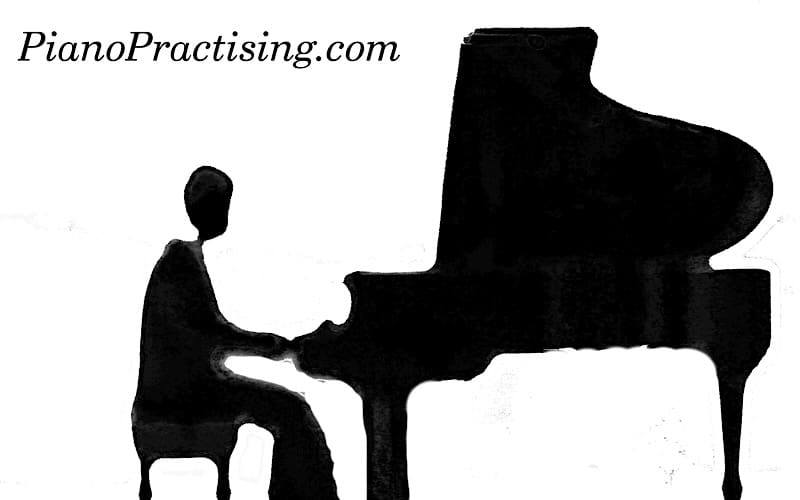So, the day has come to play on stage. Our hearts are pumping fast, our hands become surprisingly sweaty and we feel deep inside, that this is by no means an ordinary day. This is a special day. Everything feels so different than normal. And all we know, is that things are only going to be ok once we’ve finished our dreaded performance.
But in order to finish our performance commitment and get on with our lives, we need to put our fingers on the keys and start the piece.
First things first
First thing is to actually get into the mood of your piece before you even reached the stage. You don’t want to reach the piano stool only to realize that your only thought is where to put your fingers in order to start. What about your own mood? What about rhythm? What about sound? What about the style of your piece? Would you decide upon those things after you’ve started the piece? Of course not. You’re not a “pantser”; you’re not writing a novel and deciding its ultimate fate as you go along. This is music. Your playing should have been predetermined while still in the practice room, days or even months ago. The road of how to start your piece should have started before you even sat down.
So, here’s a few suggestions:
- If it is a slow piece, you don’t want to straight sit down and start; you should sit, ideally relax for a few moments, feel the piece’s gestalt and then calmly put your fingers on the keys and make your move. —just imagine a pianist appearing hotfooted from the side of the stage, crush on the stool and start the first movement of the Moonlight. That doesn’t sound like an ideal scenario, does it? Even if he played it wonderfully—I mean, you’re free to go for this type of start in this “anything-goes” era, but I just don’t know… I’m just too traditional sometimes.
- If it is a fast piece on other hand, you have more leeway to act. I sometimes sit on the piano and start immediately in order to create “suspense” and excitement —especially for an encore— I believe that, for instance, there’s no need to prepare oneself for half a minute (thus, you make the audience wait for you) to play The Flight of the Bumblebee. It could be awkward. Do you get my gist? But, it depends of course. You might want to wait for five minutes for some voguish interpretational reasons; it’s really up to you. Nikos, stop patronizing your readers!
New pianos, new idiosyncrasies
Indeed, a newly experienced piano will certainly have different idiosyncrasies from your own practising piano. Even in the same model the differences can be significant sometimes —often in the key action, which can be more annoying than sound anticipation—.
It’s like you drive a new car. You have to be extra careful; you don’t want to press the accelerator too abruptly, because your new super-fast car might react differently to your previous car that you knew so well.
So hopefully, we would have had a little bit of time to rehearse on the piano of the venue prior to our performance. If not however, we should be starting our performance pressing the keys ever so slightly more firmly in order to compensate for any unevenness of the keys or any non-sounding notes. Do not overdo it, however. You don’t want your piece to sound heavier or louder, even though in bigger concert halls abrupt pressing of the keys can be more forgiving.
Tempo Is everything
Speed is, indeed, paramount in any performance setting. You wouldn’t want to play Liszt’s Feux Follets Andante, of course, but you wouldn’t want to sabotage that piece and your technique either by playing it in your normal blistering pace on a foreign piano that has heavier action than you’re used to and force your fingers to stumble over the keys.
So, take a reasonable speed; by reasonable I do not necessarily mean slow, but, I generally imply slow-er. See how it goes. Test the waters, as they say; there will be no big difference in playing a piece in 112 instead of 114 BPM. Not a single person will notice. Not even you in a couple of years if you had to listen to the recording. The audience is going to listen to your own story —your own version of a musical story that you have the right to interpret as you may wish. They don’t know your start, ending or climactic path of your interpretation. They just wait for you to show them your version of the musical story (piece) they came to experience—
❦
Sit for a few minutes quietly at the back of the stage. Don’t dive into illustrious conversations or challenge your mind with trivial things that you can without effort resolve after your performance.
Sometimes you even have to “force” yourself to shut off your ordinary reactionary self. Find somewhere quiet to sit.
A new version of you is about to be presented on stage.
© Nikolaos Kokkinis, 29th of June 2019
=====
Our newest piece, a tango for solo piano. Just released this June.


